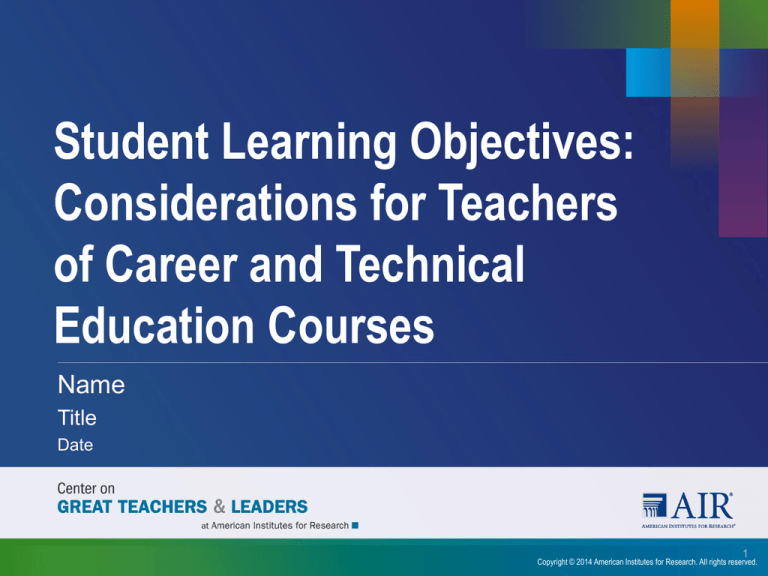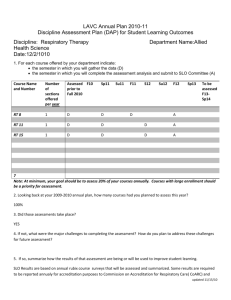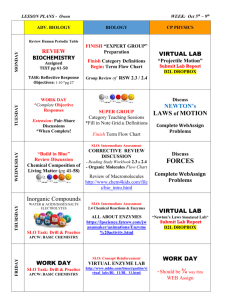
Student Learning Objectives:
Considerations for Teachers
of Career and Technical
Education Courses
Name
Title
Date
1
Copyright © 2014 American Institutes for Research. All rights reserved.
Student Learning Objectives as a
Measure of Student Growth
A student learning objective
(SLO) is a measurable,
long-term, academic goal
informed by available data
that a teacher or teacher
team sets at the beginning
of the year for all students
or for subgroups of students.
2
Who Are Teachers of Career and
Technical Education (CTE) Courses?
Teachers who link directly to an industry or occupational
area and fall into the 16 Career Clusters:
• Agriculture, Food, and Natural
Resources
• Hospitality and Tourism
• Architecture and Construction
• Information Technology
• Arts, Audiovisual Technology, and
Communications
• Law, Public Safety, Corrections, and
Security
• Business Management and
Administration
• Manufacturing
• Education and Training
• Finance
• Government and Public Administration
• Health Science
• Human Services
• Marketing
• Science, Technology, Engineering,
and Mathematics
• Transportation, Distribution, and
Logistics
3
Why Use SLOs?
Can reinforce evidence-based teaching practices
Can be used with all teachers
Can be adaptable
Can encourage collaboration
Can be used to acknowledge the value of educator
knowledge and skill
Can connect teacher practice to student learning
4
How Are SLOs Developed?
SLO Template
Baseline Data
Student Population
Interval of Instruction
Standards and Content
Assessments
Growth Targets
Rationale for Growth Targets
Instructional Strategies
5
How Are SLOs Developed?
SLO Checklist
Baseline and
Trend Data
Student
Population
Interval of
Instruction
Standards
and Content
Identifies
sources of
information
about students
Covers all
students in the
class (or in
the case of a
targeted SLO,
covers all
students in the
subgroup)
Matches
the length of
the course
(e.g., quarter,
semester,
trimester, year)
Specifies
how the SLO
will address
applicable
standards from
the highest
ranking of the
following:
(1) Common
Core State
Standards,
(2) Academic
content
standards,
(3) National
standards put
forth by
education
organizations
Draws upon
trend data, if
available
Describes
the student
population
and considers
any contextual
factors that
may impact
student
growth
Assessments
Identifies
assessments
that have
been reviewed
by content
experts to
effectively
measure
course
content and
reliably
measure
student
learning as
intended
Growth
Target(s)
Ensures all
students in the
course have a
growth target
Uses
baseline or
pretest data to
determine
appropriate
growth
Rationale for
Growth
Target(s)
Demonstrates
teacher
knowledge of
students and
content
Explains why
target is
appropriate for
the population
Addresses
observed
student needs
Uses data to
identify student
needs and
determine
appropriate
growth targets
Instructional
Strategies
Highlights
the instructional
methods that
will best
support the
student
achievement
goals set forth
in the SLO
Discusses
how the
teacher will
differentiate
instruction in
support of this
SLO
6
What Does an SLO Look Like?
Examples From the Field: Ohio (pages 1–2 in handout)
7
The SLO Evaluation Cycle
Source: Lachlan-Haché, L., Cushing, E., & Bivona, L. (2012). Student learning objectives as measures of educator effectiveness: The basics.
Washington, DC: American Institutes for Research. Retrieved from http://educatortalent.org/inc/docs/SLOs_Measures_of_Educator_Effectiveness.pdf
8
Baseline Data
Baseline and trend data can be
SLO Template
• Preassessment results
Baseline Data
• Data from previous years
Student Population
• Trend data from students over several
years
Interval of Instruction
• Progress-monitoring results
Standards and Content
• Formative assessment results
Assessments
• Summative assessment results
Growth Targets
The process for gathering baseline
Rationale for Growth Targets
and trend data provides
Instructional Strategies
opportunities for collaboration.
9
Baseline and Trend
Data
10
Student Population
Depending on state and local
rulemaking, teachers of CTE
courses may write SLOs that
focus on CTE concentrators.
SLO Template
Baseline Data
Student Population
Interval of Instruction
Standards and Content
Assessments
Growth Targets
Rationale for Growth Targets
Instructional Strategies
11
Student Population
Example SLO 1
Example SLO 2
12
Interval of Instruction
The interval of instruction is
the length of the course.
SLO Template
Baseline Data
Student Population
Interval of Instruction
Standards and Content
Assessments
Growth Targets
Rationale for Growth Targets
Instructional Strategies
13
Interval of Instruction
Example SLO 1
Example SLO 2
14
Standards and Content
These are the main content
that students must master by
the end of the course.
SLO Template
Baseline Data
Student Population
• College and career readiness
standards
Interval of Instruction
• Academic standards
Standards and Content
• Common Career Technical Core
standards
Assessments
• Industry standards
Growth Targets
Rationale for Growth Targets
Instructional Strategies
15
Standards and Content
16
Assessments
Assessments should have
“stretch” and comparability.
Possible assessments for
teachers of CTE courses
• Industry certification exams
• Unit assessments
SLO Template
Baseline Data
Student Population
Interval of Instruction
Standards and Content
• End-of-course assessments
Assessments
• Standardized commercial
assessments
Growth Targets
• Authentic assessments and work
samples
Rationale for Growth Targets
Instructional Strategies
17
Assessments
Example SLO 1
Example SLO 2
18
Growth Targets
The type of growth targets chosen
should reflect student data.
The main approaches to setting
growth targets can be used with
most types of assessments.
If the SLO includes multiple
assessments, such as unit
assessments, the growth target
component of the SLO should
include plans for combining scores
to create a single growth target.
SLO Template
Baseline Data
Student Population
Interval of Instruction
Standards and Content
Assessments
Growth Targets
Rationale for Growth Targets
Instructional Strategies
19
Examples of SLO Growth Targets
Basic Growth Target
All students have the same growth target.
Example: All of my students will grow by 20 points by the
end of the semester.
20
Examples of SLO Growth Targets
Simple Average Growth Calculation
Growth targets are determined by a common formula, but
each student has a different growth target based on his or
her preassessment score.
Example: Based on the preassessment score, students
will score halfway between their baseline score and 100.
If student scores 50 on the preassessment, his or her
growth target is 75.
If a student scores 40 on the preassessment, his or her
growth target is 70.
21
Examples of SLO Growth Targets
Tiered Growth Target
Group students together based on their preassessment
scores.
Divide students into three or more categories (low, middle,
advanced).
Example:
Preassessment Score
Growth Score
0–45 points
65
46–70 points
75
71+ points
85
22
Examples of SLO Growth Targets
Advanced Tiered Growth Target
Students have a tiered target based on their preassessment.
Divide students into three or more categories (low, middle,
advanced).
Students have to reach the greater of the two targets.
Example: Preassessment Score
Growth Score
0–45 points
65 or +35 points, whichever is greater
46–70 points
75 or +15 points, whichever is greater
71+ points
85 or +14 points, whichever is greater
23
Examples of SLO Growth Targets
Individual Growth Target
All students have individualized growth targets based on
previous performance and expectations.
Example: Student A will grow 27 points this year,
Student B will grow 38 points this year, and Student C will
grow 22 points this year.
24
Growth Targets
Example SLO 1
25
Growth Targets
Example SLO 2
26
Rationale for Targets
The rationale may describe:
SLO Template
• How the targets align to standards.
Baseline Data
• Why the targets are appropriate.
Student Population
• How the targets set expectations for
students’ employability or “soft skills”
development.
Interval of Instruction
Standards and Content
Assessments
Growth Targets
Rationale for Growth Targets
Instructional Strategies
27
Rationale for Targets
Example SLO 1
Example SLO 2
28
Instructional Strategies
Identify instructional strategies
that embed opportunities for
collaboration.
Consider the instructional
strategies that will ensure
all students meet their
growth target.
SLO Template
Baseline Data
Student Population
Interval of Instruction
Standards and Content
Assessments
Growth Targets
Rationale for Growth Targets
Instructional Strategies
29
Instructional Strategies
Example SLO 1
30
Instructional Strategies
Example SLO 2
31
Activity: Reviewing an SLO
32
Activity: Reviewing an SLO
In your group, choose one of the two sample SLOs to
review. You can choose between a culinary arts SLO or an
architecture and engineering SLO.
Using the SLO checklist, review the first draft of the sample
SLO provided in the handout.
As you review, jot down questions or feedback you have
for this teacher.
When finished, discuss your feedback with the person next
to you.
33
Activity: Writing an SLO
34
Activity: Writing an SLO
Pretend you are a first-year digital arts and design teacher.
Review the sample data provided.
Using this information, write the SLO template provided.
35
Reflection
What do you see as the potential benefits of having
teachers of CTE courses write SLOs?
What was challenging as you attempted to write this SLO?
Reflect on your experience using the SLO template and
corresponding checklist. What did you like about the
structure of these tools? What would you change to better
fit your local context?
Based on your SLO writing experience, what supports or
additional knowledge will teachers of CTE courses need to
successfully write an SLO?
36
Resources
Webinar
Supporting 21st Century Educators: How States Are
Promoting Career and Technical Educator Effectiveness
Brief
21st Century Educators: Developing and Supporting
Great Career and Technical Education Teachers
SLO Resources
Student Learning Objectives Resource Library
Introduction to Student Learning Objectives (SLOs)
37
More questions?
Contact the GTL Center!
1000 Thomas Jefferson Street NW
Washington, DC 20007-3835
877-322-8700
www.gtlcenter.org
gtlcenter@air.org
Advancing state efforts to grow, respect, and retain great teachers
and leaders for all students
38








